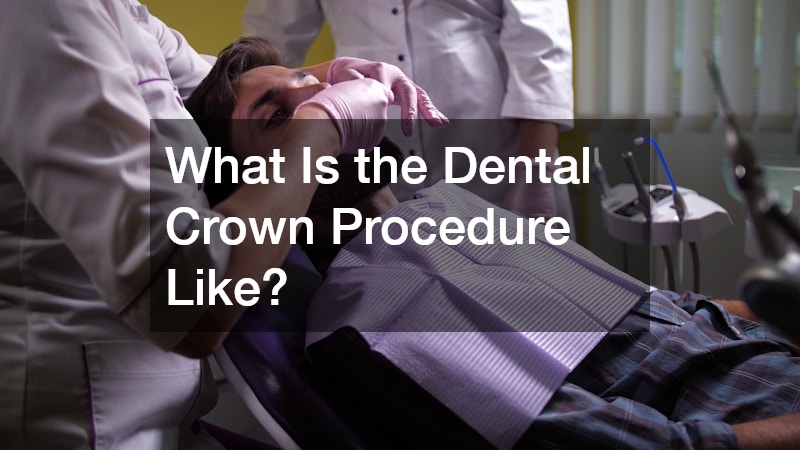Why More Patients Are Choosing Dental Crowns for Smile Repair
More people than ever are turning to dental crowns as a reliable way to restore damaged or weakened teeth. In modern dentistry, crowns have evolved from a purely functional treatment to one that also offers impressive cosmetic benefits. As materials and techniques advance, patients are realizing how much a crown can do to protect their oral health and enhance their smiles.
What Are Dental Crowns?
Definition and Functionality
A dental crown is a custom-made cap that fits snugly over a damaged tooth, restoring its original shape, size, and strength. It covers the entire visible portion of the tooth, protecting it from further decay or fracture.
Dentists recommend crowns when a tooth can no longer be repaired effectively with a filling or bonding material.
Materials Used in Crowns
There are several materials used to make dental crowns, including porcelain, ceramic, resin, and metal alloys. Porcelain and ceramic crowns are especially popular for front teeth because they closely resemble natural enamel. Metal or porcelain-fused-to-metal options are often chosen for back teeth that require additional strength. Zirconia crowns have also gained attention for their durability and natural look.
The Process of Getting Dental Crowns
The process of receiving a dental crown usually takes two visits. During the first visit, the dentist reshapes the tooth and takes an impression. A temporary crown protects the tooth while the permanent version is custom-made in a lab. On the second visit, the permanent crown is fitted, adjusted for comfort, and cemented securely in place.
Types of Dental Crowns
Common types include all-porcelain, all-metal, porcelain-fused-to-metal (PFM), and zirconia. The best choice depends on factors such as tooth location, bite force, and cosmetic preference.
Common Uses for Dental Crowns
Dentists use dental crowns to:
-
Strengthen teeth weakened by decay or fractures
-
Restore broken or worn-down teeth
-
Cover a tooth after root canal treatment
-
Anchor dental bridges
-
Cover dental implants
-
Improve tooth color, shape, or alignment
Why Are Dental Crowns Popular for Smile Repair?
Durability and Longevity
One of the main reasons for their popularity is how long dental crowns last. With proper care, they can remain in great condition for 10 to 15 years or more. Their resistance to chipping and cracking makes them a dependable choice for long-term tooth protection.
Enhanced Aesthetics
Crowns are carefully color-matched to your natural teeth, helping create a seamless and confident smile. They conceal discoloration, misshapen teeth, or imperfections that simple fillings cannot correct.
Versatility in Dental Treatments
Dental crowns can be used alongside many other treatments, from bridges to implants, making them one of the most versatile options in restorative dentistry.
Cost-Effectiveness Compared to Alternatives
While the upfront cost of a crown may be higher than a filling, it’s often more cost-effective in the long run. Because crowns are durable and long-lasting, they reduce the likelihood of future repairs or replacements.
How Do Dental Crowns Compare to Other Dental Restorations?
Dental Crowns vs. Veneers
Veneers only cover the front surface of a tooth, making them ideal for cosmetic improvements. Dental crowns, however, encase the entire tooth and provide structural reinforcement, which veneers cannot offer.
Dental Crowns vs. Fillings
Fillings repair smaller cavities, but when a tooth is severely weakened, a crown is the more stable and protective choice.
Dental Crowns vs. Implants
Implants replace missing teeth entirely, while crowns restore existing ones. In fact, an implant is often completed with a crown on top to mimic a natural tooth.
Dental Crowns vs. Bridges
A bridge replaces one or more missing teeth and is supported by crowns placed on the surrounding teeth. Without crowns, bridges wouldn’t have the necessary strength or stability.
What Is the Dental Crown Procedure Like?
Initial Consultation and Assessment
Your dentist examines the affected tooth, takes X-rays, and discusses your treatment options.
Preparation and Impressions
The tooth is reshaped, and impressions are taken to ensure a perfect fit for your dental crown.
Temporary Crown Placement
A temporary crown protects the prepared tooth while the permanent one is fabricated in a lab.
Final Crown Fitting
During your second visit, the new crown is placed, checked for comfort, and bonded securely.
What Are the Potential Drawbacks of Dental Crowns?
Possible Tooth Sensitivity
Some patients experience mild sensitivity to temperature after placement, but this usually subsides within days.
Cost Considerations
Crowns can be more expensive than fillings, though their longevity often offsets the cost over time.
Risk of Crown Damage
Like natural teeth, crowns can chip or loosen if you bite down on hard foods.
Complications with Underlying Tooth
If decay forms beneath a crown, it must be addressed promptly to avoid further issues.
Need for Replacement or Adjustment
Over time, wear or gum recession may require a crown to be replaced or adjusted.
Dental crowns continue to play a major role in modern dentistry because they successfully combine beauty and function. They offer long-lasting protection, enhance aesthetics, and restore confidence in your smile. Whether you need to strengthen a damaged tooth or improve your appearance, dental crowns remain one of the most effective and trusted restorative treatments available today.




